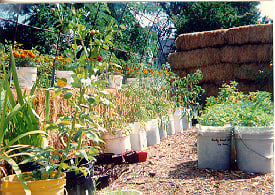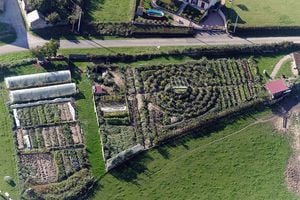
Permaculture is a form of whole systems design based on the sustainability of natural systems, seeking to reproduce that sustainability in our living environment. Permaculture designs differ based on climatic factors, bioregion, organizational goals, personal preferences and other factors. They integrate "land, resources, people and the environment through mutually beneficial synergies – imitating the no waste, closed loop systems seen in diverse natural systems"[1] It can hence be said that permaculture is, at its core, a set of thinking tools, in particular towards awareness of context, threats and opportunities.
The holistic approach of permaculture integrates "agriculture, water harvesting and hydrology, energy, natural building, forestry, waste management, animal systems, aquaculture, appropriate technology, economics and community development".[1]
- See Permaculture wiki for an explanation of how Appropedia works for permaculture.
History[edit | edit source]


Permaculture was initially conceptualized by Bill Mollison and David Holmgren in Australia during the 1970's. Mollison and Holmgren sought to reverse the environmental degradation that seemed to follow closely on the heels of modern development while simultaneously increasing the sustainability of food production systems by promoting localized self-reliance. Though it was developed out of sustainable agriculture, permaculture design is hypothetically applicable to any field of human endeavor. The very term "permaculture" itself was first used to mean "permanent agriculture,"[2] it is now applicable to all realms of design and is now considered to mean "permanent culture".[3] In recent years, social and economic permaculture have been receiving more attention.
In a strict sense, "permaculture" refers to the system developed by Mollison, Holmgren, and their successors. However, some use the term "permaculture" in a broader sense to refer to practices of indigenous and traditional peoples around the world, such as chinampas from Mexico or zai from West Africa. Contemporary innovators are often also included under the permaculture umbrella such as Masanobu Fukuoka and Sepp Holzer.
What permaculture is about[edit | edit source]
The prime directive of permaculture as stated by Mollison is that "the only ethical decision is to take responsibility for our own existence and that of our children. Make it now."
The three interwoven ethics guiding permaculture are: Earth Care, People Care, and Fair Share/Return the Surplus. To borrow a concept from Buddhism, Right Action occurs when all three ethics are actualized by a given action or design decision.
One way to look at permaculture is being counter to the linear perspective much of the developed world operates in. An example would be how consumerism functions; we buy a product, unwrap it and throw away the wrapper, use the product, then throw it away as well, the product then travels to a landfill where it is disposed of. Stuff in, stuff out. In permaculture everything is viewed in more of a circular fashion; there is no waste. If you find yourself discarding something then you have a resource you have not discovered how to utilize. Everything must find balance; you may think you have a beetle problem, but what you really have is a duck shortage...
Ethics[edit | edit source]
These 3 broad ethic principles are part of permaculture thinking.
- Care for the earth (husband soil, forests and water)
- Care for people (look after self, kin and community)
- Fair share (set limits to consumption and reproduction and redistribute surplus).
12 principles of permaculture[edit | edit source]
Following on the 3 ethic principles, a set of guidelines are made:
- Observe and interact. Take time to engage with nature, so we can design solutions for our particular situation.
- Catch and store energy: Develop systems that collect resources when abundant, & use them in times of need.
- Obtain a yield - Ensure that you are getting truly useful rewards as part of the work that you are doing.
- Apply self-regulation & accept feedback - Discourage inappropriate activity so systems continue to function well.
- Use and value renewable resources and services - Make the best use of nature's abundance.
- Produce no waste - Valuing and make use of all the resources available to us, so nothing goes to waste.
- Design from patterns to details - Step back and observe patterns in nature and society. Details come after.
- Integrate rather than segregate - Put the right things in the right place, so relationships and support develop.
- Use small, slow solutions - easier to maintain than big systems, better use of local resources, more sustainable.
- Use and value diversity - reduces vulnerability to threats and takes advantage of the environment.
- Use edges & value the marginal - often the most valuable, diverse and productive elements in the system.
- Have a positive impact on inevitable change by carefully observing, and then intervening at the right time.
These are principles used and taught by the pioneers of permaculture - they are not universal truths. E.g. re "Use small, slow solutions": in certain contexts, big and fast-acting solutions may be best; however the principle reminds us that great impacts can come in ways that require patience and are not flashy.
A plant's relationships[edit | edit source]

Permaculture is relationship-oriented and is based on close observation, critical thinking, and a systems perspective. Individual plant types are not chosen discretely, but relationships between organisms and communities of organisms are to be woven together carefully, considering each plant's relationships to fellow organisms, the overall ecosystem, and the people whose needs it is intended to meet.
Knowledge of such relationships is critical to the practice of Permaculture design, our understanding of ecological processes, our capacity for systems thinking.
Consider for example the role of microorganisms in soil, which have a profound effect on the fertility of the soil and the health of the plant. See Effective Microorganisms.
The goal of permaculture is to satisfy basic human needs without compromising the needs of the Earth.
Permaculture as appropriate technology[edit | edit source]
One popular understanding of permaculture is as a set of tools for applied ecology. However, a more accurate description would be: a decision-making system for determining the best tools to use for a particular situation. For example, a permaculture designer would likely not recommend building a log cabin in an arid desert for a number of reasons. First, there would probably be few if any timber-quality trees near the design site, thus requiring them to be brought in from a considerable distance. Also, lumber buildings would be less capabl creating a comfortable temperature gradient compared to other materials like adobe. At its core, permaculture is about determining the appropriateness of a variety of elements within a given context.
Many perspectives[edit | edit source]
Permaculture means many different things to many different people, and nothing to some. There is no one correct definition, as permaculture is holistic, integrated, and applicable on all levels and in all situations. At its core, permaculture is a philosophy of interdependence and ethical responsibility actualized through a whole-systems design methodology and on-the-ground action. Permaculture is grounded by ethics and guided by ecological principles, traditional cultural values, and applied scientific understanding. Permaculture is being applied at increasing rates and diversity around the world to develop strategic, long-term, practical solutions to the challenges facing humanity and the ecosystems of which we are a part.
Zoning[edit | edit source]

Zoning means dividing a certain piece of land into several zones, with the family house in the center. All of these have a function to the owner of the land. Although this generally creates a rather artificial vegetation pattern, it creates an environment that has benefits both for the owner of the land, as well as well as for nature (to some degree). A more serious issue of permaculture (namely the use of non-indigenous and sometimes domesticated species of fauna/flora) can be reduced with zoning however. This, by placing domesticated (and generally more efficient) species near the center/home, and using indigenous species in the zones further away from the center.
Permaculture Zones (from Wikipedia) are a way of organizing design elements in a human environment on the basis of the frequency of human use and plant or animal needs. Frequently manipulated or harvested elements of the design are located close to the house in zones 1 and 2. Less frequently used or manipulated elements, and elements that benefit from isolation (such as wild species) are farther away. Zones are about positioning things appropriately. Zones are numbered from 0 to 5.
- Zone 0
- The house, or home center. Here permaculture principles would be applied in terms of aiming to reduce energy and water needs, harnessing natural resources such as sunlight, and generally creating a harmonious, sustainable environment in which to live and work. Zone 0 is an informal designation, which is not specifically defined in Mollison's book.
- Zone 1
- The zone nearest to the house, the location for those elements in the system that require frequent attention, or that need to be visited often, such as salad crops, herb plants, soft fruit like strawberries or raspberries, greenhouse and cold frames, propagation area, worm compost bin for kitchen waste, etc. Raised beds are often used in zone 1 in urban areas.
- Zone 2
- This area is used for siting perennial plants that require less frequent maintenance, such as occasional weed control or pruning, including currant bushes and orchards. This would also be a good place for beehives, larger scale composting bins, and so on.
- Zone 3
- The area where maincrops are grown, both for domestic use and for trade purposes. After establishment, care and maintenance required are fairly minimal (provided mulches and similar things are used), such as watering or weed control maybe once a week.
- Zone 4
- A semi-wild area. This zone is mainly used for forage and collecting wild food as well as timber production.
- Zone 5
- A wild area. There is no human intervention in zone 5 apart from the observation of natural ecosystems and cycles.
See also[edit | edit source]
- Urban permaculture
- Organic agricultural system
- Integrated Pest Management
- Selecting of plants with sequential fruiting times/Seasonal eating
- Organopónico[4]
- Sustainable agriculture
- Suitable crops by region: indicates which crops are native to a region and can thus be used
- How to Practice Sustainable Agriculture
- Regenerative Design (organization)
- Bioneering
- Chicken Tractor (Optimized Construction and Design)
- Agroforestry
- Food forests
- Zero waste
- quantifying ecological value
External links[edit | edit source]
- Wikipedia:Permaculture
- Wikipedia:Category:Permaculture for a collection of articles.
- Introduction to Permaculture course FREE Online course@Oregon State University(by ANDREW MILLISON). There is also playlist 66 videos from 2016
- Permaculture: A Brief Introduction (dead link), by Jillian Hovey (2000)
- Permaculture Information Web
- Permaculture Forums at Permies.com
- Permaculture Design forumsat Permies.com
- Permaculture Design Course
- Permaculture Design Courseat Wheaton Labs
- Permaculture and Homesteading resourcesat Permies.com
- Permacultureat Permies.com
- Permaculture podcastsat Permies.com
- Permaculture videosat Paul Wheaton's You Tube Channel
- Permaculture trainingat Wheaton Labs
- Permaculture Tech Jamboreeat Wheaton Labs
- Skills to Inherit Property - Permaculture trainingat Wheaton Labs
- [2] Permaculture Research Institute (US)
- [3] Permaculture News
- [4] Toby Hemenway's Pattern Literacy
- PermacultureCommons.org: Free and open permaculture material
- [5] Permaculture Association - the basics
- Map of projects in the german speaking part of europe
- Permaculture Soil and Weed Management (Garden Master Course)
References[edit | edit source]
- ↑ 1.0 1.1 What is Permaculture - The Permaculture Research Institute
- ↑ This term was taken from the subtitle of the 1909 book Farmers of Forty Centuries, Or Permanent Agriculture in China, Korea, and Japan by F. H. King.
- ↑ Gaia's Garden, pg 4 by Toby Hemenway
- ↑ Organopónico